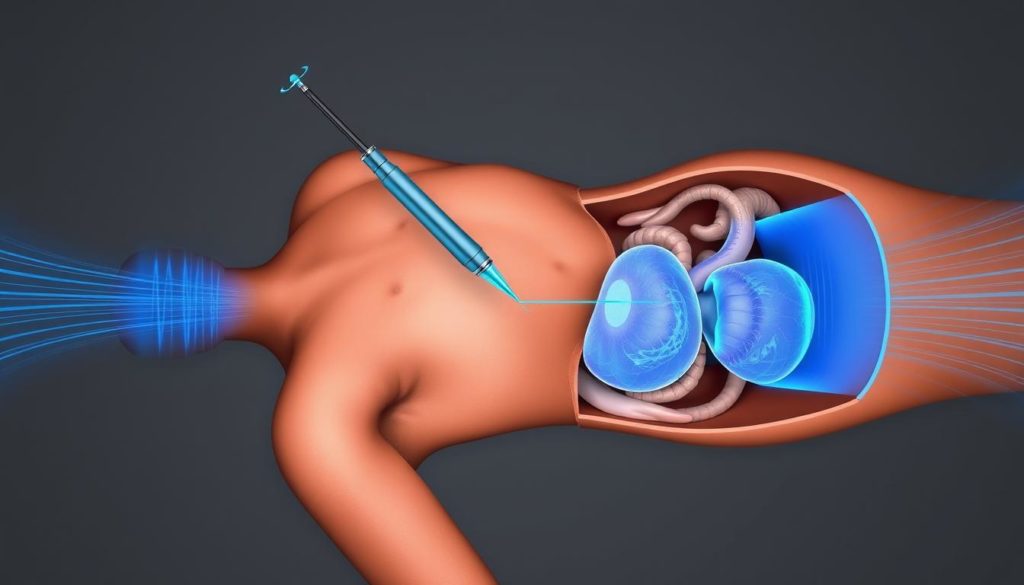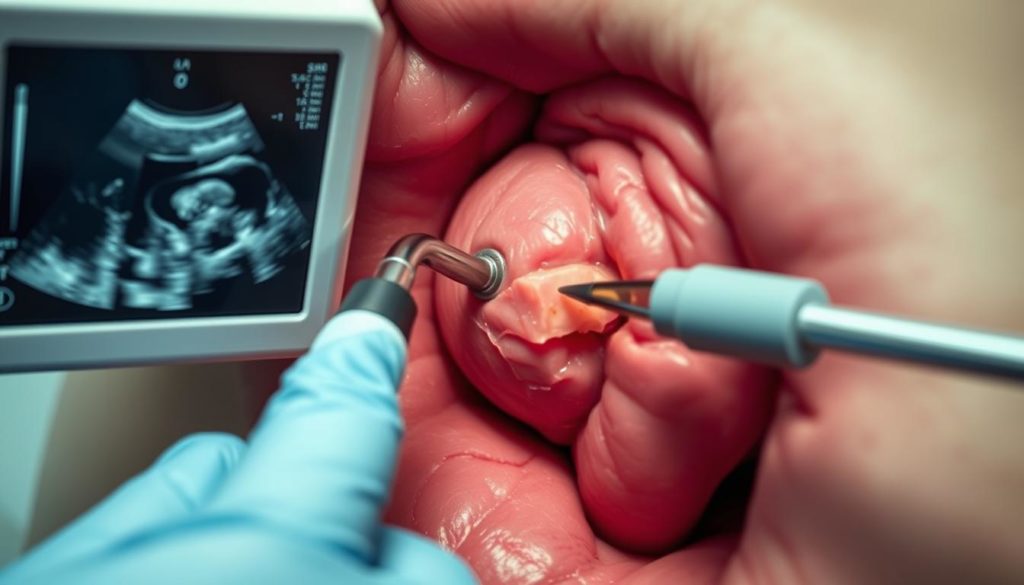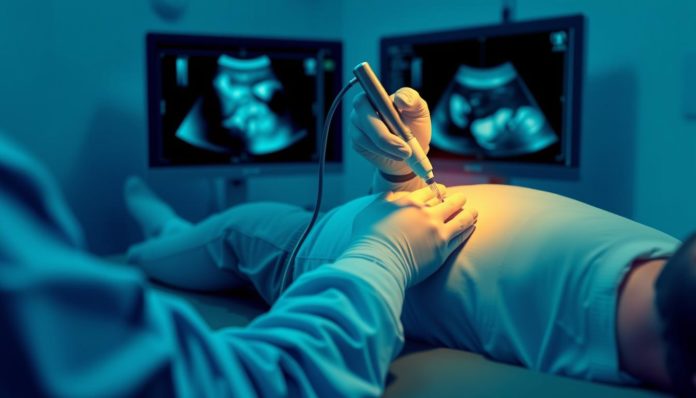Did you know that prostate cancer is a leading cancer among American men? This fact shows the necessity for precise diagnosis. The Transrectal Ultrasound (TRUS) Prostate Biopsy plays a key role in cancer detection. It provides a clear view of the prostate, helping to take accurate biopsy samples.
The TRUS procedure is usually done with local anesthesia in a clinic. It’s known for being quick and safe. Getting to know the TRUS method is vital for understanding prostate health. This guide will cover the procedure, how to prepare, and care afterwards. This ensures the best results and recovery.
What is a Transrectal Ultrasound Prostate Biopsy?
A Transrectal Ultrasound Prostate Biopsy (TRUS biopsy) is key in preventing prostate cancer. It uses ultrasound imaging to guide a needle for tissue sample collection. This method enables doctors to accurately diagnose the patient.

Definition and Purpose
The Transrectal Ultrasound Prostate Biopsy uses sound waves to create clear prostate images. These images help direct the needle to the right spot for precise sample collection. It’s mainly used to check for prostate cancer or other issues.
Doctors advise a TRUS biopsy after finding abnormal test results. This could be from MRI scans, high PSA levels, or a DRE.
Procedure Overview
For the ultrasound-guided biopsy, a small probe goes into the rectum. It shows live pictures of the prostate. These pictures guide the biopsy needle to the correct parts of the gland to get tissue samples.
| Step | Description |
|---|---|
| Preparation | Patient is positioned, and an ultrasound probe is inserted into the rectum. |
| Imaging | Ultrasound images are captured to visualize the prostate. |
| Biopsy | Using ultrasound guidance, a needle collects tissue samples. |
| Completion | Procedure typically concludes within 20-30 minutes. |
This technique is designed to be less painful and more accurate for cancer detection. Afterward, the samples are sent to a lab for detailed analysis.
Why is a Transrectal Ultrasound Prostate Biopsy Necessary?
A transrectal ultrasound prostate biopsy is key for accurately diagnosing prostate cancer. It is especially used after tests like PSA blood tests or digital rectal exams (DRE) show prostate issues. This method is important because it helps find cancer early by focusing on problem areas.

Having a prostate cancer screening with a TRUS biopsy improves chances of finding cancer early. This is critical for good treatment results. Detecting cancer early lets doctors treat patients more effectively, leading to better health outcomes for men.
| Preliminary Test | Purpose | Follow-up Procedure |
|---|---|---|
| PSA Blood Test | Measures prostate-specific antigen levels | Transrectal Ultrasound Prostate Biopsy |
| DRE (Digital Rectal Exam) | Detects irregularities or lumps in the prostate | Transrectal Ultrasound Prostate Biopsy |
A transrectal ultrasound prostate biopsy is crucial for confirming if it’s prostate cancer and planning treatment. Catching cancer early with this biopsy increases the chances of good results. This highlights the importance of checking for prostate cancer early and regularly.
Preparing for Your TRUS Biopsy
Getting ready for your TRUS biopsy is key. It makes sure the process is smooth and successful. Knowing what steps to take, from what your doctor tells you before to taking certain meds and following diet rules, is very important.
Pre-appointment Instructions
Before your biopsy, you’ll get specific instructions. You might need a urine test to check for infections and antibiotics to stop complications after. Clearing your bowel with an enema or laxatives is often advised too. This makes the biopsy more precise and clean.
Medications to Consider
Talking about your meds with your doctor before a TRUS biopsy is crucial. This matters a lot if you’re on blood thinners like warfarin or drugs that prevent blood clots. Changing these meds before your biopsy can lower bleeding risks.
Dietary Guidelines
Following certain diet rules is key before your biopsy. You might need to stick to clear liquids or fast for a bit. These steps are to make sure your bowel is empty. This gives a better view during the biopsy and lowers risks.
The TRUS Biopsy Procedure: Step-by-Step
The TRUS biopsy journey starts before the actual sampling. It’s key in diagnosing prostate cancer. We’ll guide you through the biopsy steps, from prep to what happens during it.
Initial Preparation
Preparing for a TRUS biopsy involves a few key steps. These ensure comfort and precision. First, the patient changes into a gown. They then lie on their side, knees to chest. This position gives the best prostate access.
A local anesthetic is given next to ease pain. This step is vital for comfort and procedure success. Ensuring the anesthesia works right sets up for the steps that follow.
During the Procedure
After numbing, the biopsy begins. An ultrasound probe enters the rectum to see the prostate. This helps guide the biopsy needle right.
With ultrasound help, the doctor collects prostate samples. Usually, this means 12 to 15 samples, based on MRI scans and concern areas. These samples are vital for accurate cancer diagnosis.
The TRUS biopsy shows how far medical tech has come. It’s a big help in catching prostate cancer early and correctly.
What to Expect After a TRUS Biopsy
A Transrectal Ultrasound Prostate Biopsy (TRUS) is vital for identifying prostate problems. Knowing what comes after the biopsy helps make recovery easier. This article talks about how to care for yourself after the biopsy and when to call a doctor.
Immediate Aftercare
After the procedure, patients are watched for a bit, then they can go home. It’s key to drink more fluids for the next 24 hours. This clears any drugs from your body and fights infection. Also, resting well is important. Avoid hard work during this time.
| Action | Details |
|---|---|
| Resting | Take things easy and avoid any heavy lifting or vigorous activities. |
| Hydration | Drink plenty of fluids to help flush out the system and prevent infection. |
| Diet | Return to a normal diet unless otherwise instructed by your doctor. |
| Pain Management | Use pain medications as prescribed, or take warm baths to ease discomfort. |
Following these steps can help you recover better and faster. It’s important to stick to the care tips given for a good recovery.
When to Seek Medical Attention
Mostly, the side effects are mild. However, you must call your doctor immediately if things seem off. If you have heavy bleeding, signs of infection like fever, or pain that won’t go away, get help. These symptoms can mean there are complications that need quick action.
Pay attention and care for yourself properly after the biopsy. Make sure to talk to your healthcare provider about any worries during recovery.
Possible Risks and Side Effects
Getting a transrectal ultrasound-guided prostate biopsy is a key step in checking for prostate cancer. While this procedure is safe for many, it’s still important to know what could go wrong. This awareness helps you get ready for what might happen.
Common Side Effects
Most people only have small problems after a TRUS biopsy. These prostate biopsy side effects include:
- Hematuria (blood in the urine)
- Hematochezia (blood in the stool)
- Hematosepermia (blood in the semen)
- Rectal bleeding
- Pain or discomfort in the pelvic area
- Vasovagal episodes (fainting)
- Genitourinary tract infections
These side effects usually don’t last long. They often go away in a few days. A study found that about 16.9% of people have these complications.
Rare Complications
Sometimes, a TRUS biopsy can cause serious problems, although it’s not common. These issues include:
- Urosepsis: A severe infection that spreads in the bloodstream
- Major rectal bleeding that needs doctor’s care
- Acute urinary retention
These problems don’t happen often, but they are important to know about. Talking with your doctor about these risks is a good idea. This helps you understand and get ready for any possible problems. For more information, look into this detailed study.
Understanding Your Biopsy Results
Getting your biopsy results back can be very emotional. It’s key to understand the process and how long it will take. Usually, it takes about one to three weeks to get TRUS biopsy results.
Timeline for Results
How fast you get the results depends on the lab’s workload and how complex the test is. During this time, the pathologist looks closely at the tissue samples to find any signs of cancer. It’s a good chance for patients to get ready emotionally and seek support from loved ones.
Interpreting the Findings
When the results are in, your doctor will go over them with you. If cancer is found, they will talk about the prostate cancer grading. This grading tells you how aggressive the cancer is. It uses the Gleason score, which goes from 2 to 10, where a higher score means a more aggressive cancer.
They will also discuss what comes next, whether it’s treatment or more tests. This helps in making informed decisions about your care. Knowing how to understand your biopsy results helps you explore your treatment options better, aiming for the best outcome.
Alternatives to Transrectal Ultrasound Prostate Biopsy
Looking into other biopsy methods can be greatly beneficial for patients. They often worry about the risks that come with a traditional TRUS biopsy.
Transperineal Biopsy
A transperineal biopsy stands out as a safer choice for many. It poses a lower infection risk than the transrectal method. It accesses the prostate through the perineum, avoiding rectal bacteria. This keeps patients safer without compromising on the accuracy of the diagnosis.
Other Imaging Techniques
Prostate MRI, particularly multiparametric MRI (mpMRI), is becoming a preferred option. It helps spot concerning areas within the prostate better. This technique leads to more precise biopsies or even skipping some that aren’t needed. The American Urological Association (AUA) endorses MRI for enhancing biopsy results. It’s seen as a key asset for doctors.
For further details on these options, check out this resource on prostate biopsy alternatives.
| Technique | Benefits | Drawbacks |
|---|---|---|
| Transperineal Biopsy | Lower risk of infection and sepsis, high diagnostic accuracy | May require general anesthesia, slightly longer recovery |
| Prostate MRI | Non-invasive, accurate identification of suspicious areas, potentially avoids unnecessary biopsies | Higher cost, limited availability |
Importance of Prostate Cancer Screening
Screening for prostate cancer is key for men’s health. Early detection plays a major role in treatment success. Methods like PSA tests and Digital Rectal Exams spot issues early.
PSA testing monitors prostate health effectively. It measures prostate-specific antigen levels in the blood. This helps catch prostate issues early, improving chances of successful treatment.
It’s not just about catching cancer early. It’s also managing prostate health well. Improved screening techniques help find serious issues while avoiding over-diagnosis. This means getting the right treatment without extra procedures.
To wrap it up, consistent screening is crucial. Proactive prostate health checks allow for early problem detection. This leads to better long-term health outcomes for men.
Prostate Health Tips Post-Biopsy
After a transrectal ultrasound prostate biopsy (TRUS), caring for yourself is key. To ensure a smooth recovery, it is important to stay well-hydrated. Drinking lots of water helps clean your urinary system, which lowers infection risk and helps healing.
Avoiding heavy activities is crucial during the recovery. Heavy lifting or intense workouts could lead to bleeding and slow your recovery. Try to rest and move gently instead. Consider light walks to help your blood flow without stressing the prostate.
Finishing any prescribed antibiotics is crucial to avoid infections after the biopsy. It’s also important to see your doctor for a follow-up. A check-up after your biopsy makes sure any issues are caught early and keeps your prostate health on track.
Following these recovery tips will aid in a smoother healing process. Remember, talking regularly with your doctor after the biopsy is very important for your health.
FAQ
What is a Transrectal Ultrasound Prostate Biopsy (TRUS biopsy)?
A Transrectal Ultrasound Prostate Biopsy is a procedure. It collects tissue samples from the prostate gland using ultrasound and a needle. This helps in detecting cancer and other abnormalities.
Why is a TRUS biopsy necessary?
A TRUS biopsy is needed when tests like PSA or DRE show possible prostate issues. It’s crucial for diagnosing prostate cancer and checking the prostate’s health with precision.
How should I prepare for a TRUS biopsy?
Preparation includes following the doctor’s instructions closely. Adjust medications as advised, and follow specific diet guidelines. An enema or laxatives may be needed for bowel clearance.
A urine test might be required to check for infection. Antibiotics could be prescribed to avoid infection risks.
What happens during the TRUS biopsy procedure?
You’ll wear a hospital gown and lie on your side, knees pulled up. A local anesthetic is applied. Then, an ultrasound probe goes into the rectum to guide the biopsy needle.
Usually, 12 to 15 samples of prostate tissue are taken for analysis.
What should I expect after the TRUS biopsy?
After the biopsy, there’s a brief monitoring period before you can go home. It’s advised to drink lots of fluids for the day following. Seek immediate medical help if you notice signs of infection or heavy bleeding.
Recovery includes taking it easy, returning to your usual diet, and managing any soreness with medication or warm baths.
What are the possible risks and side effects of a TRUS biopsy?
Common side effects are blood in urine, stool, or semen, and discomfort. Though rare, complications like ongoing bleeding, infections, or needing more samples can happen. The overall risk is low.
How long does it take to get TRUS biopsy results?
Results usually come in from one to three weeks. They provide a diagnosis and show the cancer’s grade and how aggressive it is. This guides further treatment plans.
Are there alternatives to a TRUS biopsy?
Yes, alternatives like a Transperineal Biopsy offer a lower infection risk. Imaging techniques like a multiparametric MRI can also pinpoint biopsy areas. This helps in avoiding unnecessary procedures.
Why is prostate cancer screening important?
Screening is vital for catching prostate cancer early, which makes treatment more effective. It includes PSA tests and DRE exams. For higher-risk individuals, a TRUS biopsy might be suggested. New advancements aim to find a balance in early detection and avoiding over diagnosing.
How can I maintain prostate health post-biopsy?
Keep hydrated and avoid heavy activities to prevent bleeding after the biopsy. Be sure to finish any antibiotics you’re given. Follow-up appointments are important for monitoring and any questions you may have, ensuring a thorough post-biopsy care.


